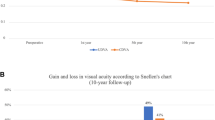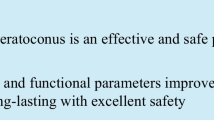Abstract
Purpose
To assess risk factors for progression following corneal collagen crosslinking (CXL) in eyes with keratoconus.
Methods
Charts of patients who developed progression following conventional CXL treatment (Dresden protocol) were retrospectively evaluated in two centers (Center 1 and Center 2). 871 eyes of a total of 676 patients were analyzed. Progression was defined as > 1 diopter (D) increase in maximum keratometry (Kmax) readings compared to baseline.
Results
Progression was noted in 20 eyes of 20 patients (progression rate 3%). The mean age of the patients was 17.65 ± 5.76 (11–34)-years-old, and the mean follow-up following CXL was 36.70 ± 25.72 (12–84)-months-old. The gender distribution was 13 (65%) females and seven (35%) males. Four eyes (20%) had mild, 13 eyes (65%) had moderate, and three eyes (15%) had severe keratoconus at baseline. Fifteen eyes (75%) had allergic conjunctivitis, and 20 eyes (100%) reported eye-rubbing. Cone location was central in 17 (85%) eyes, and peripheral in 3 (15%) eyes. A mean of 2.21 ± 1.30 D (1.00–5.30 D) steepening was determined at Kmax 6 to 82 months following CXL treatment.
Conclusions
Progression rate was found to be higher in the patients under the age of 17 years, female gender, allergic conjunctivitis, high preoperative Kmax (> 57 D), thin corneas (< 430 µm). The majority of progressive patients were central cone and moderate keratoconus.

Similar content being viewed by others
References
Rabinowitz YS (1998) Keratoconus. Surv Ophthalmol 42:297–319. https://doi.org/10.1016/S0039-6257(97)00119-7
Gordon-Shaag A, Millodot M, Essa M, Garth J, Ghara M, Shneor E (2013) Is consanguinity a risk factor for keratoconus? Optom Vis Sci 90:448–454. https://doi.org/10.1097/OPX.0b013e31828da95c
Wollensak G, Spoerl E, Seiler T (2003) Riboflavin/ultraviolet-A–induced collagen crosslinking for the treatment of keratoconus. Am J Ophthalmol 135:620–627. https://doi.org/10.1016/S0002-9394(02)02220-1
Hersh PS, Stulting RD, Muller D, Durrie DS, Rajpal RK (2017) United States multicenter clinical trial of corneal collagen crosslinking for keratoconus treatment. Ophthalmology 124:1259–1270. https://doi.org/10.1016/j.ophtha.2017.03.052
Raiskup F, Theuring A, Pillunat LE, Spoerl E (2015) Corneal collagen crosslinking with riboflavin and ultraviolet-A light in progressive keratoconus: ten-year results. J Cataract Refract Surg 41:41–46. https://doi.org/10.1016/j.jcrs.2014.09.033
Zotta PG, Diakonis VF, Kymionis GD, Grentzelos M, Moschou KA (2017) Long-term outcomes of corneal cross-linking for keratoconus in pediatric patients. J AAPOS 21:397–401. https://doi.org/10.1016/j.jaapos.2017.07.205
Lang SJ, Bischoff M, Böhringer D, Seitz B, Reinhard T (2014) Analysis of the changes in keratoplasty indications and preferred techniques. PLoS ONE 9:e112696. https://doi.org/10.1371/journal.pone.0112696
Gokul A, Patel DV, Watters GA, McGhee CN (2017) The natural history of corneal topographic progression of keratoconus after age 30 years in non-contact lens wearers. Br J Ophthalmol 101:839–844. https://doi.org/10.1136/bjophthalmol-2016-308682
Wang YM, Chan TC, Yu M, Jhanji V (2017) Shift in progression rate of keratoconus before and after epithelium-off accelerated corneal collagen crosslinking. J Cataract Refract Surg 43:929–936. https://doi.org/10.1016/j.jcrs.2017.04.033
Wang YM, Chan TC, Marco CY, Jhanji V (2018) Comparative evaluation of progression rate in keratoconus before and after collagen crosslinking. Br J Ophthalmol 102:1109–1113. https://doi.org/10.1136/bjophthalmol-2017-311017
Zadnik K, Barr JT, Edrington TB, Everett DF, Jameson M, McMahon TT, Gordon MO (1998) Baseline findings in the Collaborative Longitudinal Evaluation of Keratoconus (CLEK) Study. Invest Ophthalmol Vsi Sci 39:2537–2546
Henriquez MA, Villegas S, Rincon M, Rincon M, Maldonado C, JrL I (2018) Long-term efficacy and safety after corneal collagen crosslinking in pediatric patients: Three-year follow-up. Eur J Ophthalmol 28:415–418. https://doi.org/10.1177/1120672118760149
Miraftab M, Hashemi H, Abdollahi M, Nikfar S, Asgari S (2019) The efficacy of standard versus accelerated epi-off corneal cross-linking protocols: a systematic review and sub-group analysis. Int Ophthalmol 39:2675–2683. https://doi.org/10.1007/s10792-019-01091-y
Uçakhan ÖÖ, Bayraktutar BN, Saglik A (2016) Pediatric corneal collagen cross-linking: long-term follow-up of visual, refractive, and topographic outcomes. Cornea 35:162–168. https://doi.org/10.1097/ICO.0000000000000702
Ferdi AC, Nguyen V, Gore DM, Allan BD, Rozema JJ, Watson SL (2019) Keratoconus natural progression: a systematic review and meta-analysis of 11 529 eyes. Ophthalmology 126:935–945. https://doi.org/10.1016/j.ophtha.2019.02.029
Koller T, Mrochen M, Seiler T (2009) Complication and failure rates after corneal crosslinking. J Cataract Refract Surg 35:1358–1362. https://doi.org/10.1016/j.jcrs.2009.03.035
Munsamy AJ, Moodley VR, Naidoo P, Mangwarara TR, Abdullah R, Govender D, Dlamini P (2015) A frequency analysis of cone characteristics for the different stages of keratoconus. Afr Vis Eye Health 74:6. https://doi.org/10.4102/aveh.v74i1.302
Brown SE, Simmasalam R, Antonova N, Gadaria N, Asbell PA (2014) Progression in keratoconus and the effect of corneal cross-linking on progression. Eye Contact Lens 40:331–338. https://doi.org/10.1097/ICL.0000000000000085
Author information
Authors and Affiliations
Contributions
All authors contributed to the study conception and design. Material preparation, data collection, and analysis were performed by AS, GÖ, and ÖU. The first draft of the manuscript was written by AS, and all authors commented on previous versions of the manuscript. All authors read and approved the final manuscript.
Corresponding author
Ethics declarations
Conflict of interest
All authors certify that they have no affiliations with or involvement in any organization or entity with any financial interest (such as honoraria; educational grants; participation in speakers’ bureaus; membership, employment, consultancies, stock ownership, or other equity interest; and expert testimony or patent-licensing arrangements), or non-financial interest (such as personal or professional relationships, affiliations, knowledge, or beliefs) in the subject matter or materials discussed in this manuscript.
Ethical approval
Approval for the study was given by the local ethics committee (Ethics acceptance number: HRU/20.19.2), and all transactions were carried out in accordance with the Declaration of HELSINKI. Written informed consent was obtained from all patients before the study.
Additional information
Publisher's Note
Springer Nature remains neutral with regard to jurisdictional claims in published maps and institutional affiliations.
Rights and permissions
About this article
Cite this article
Sağlık, A., Özcan, G. & Uçakhan, Ö. Risk factors for progression following corneal collagen crosslinking in keratoconus. Int Ophthalmol 41, 3443–3449 (2021). https://doi.org/10.1007/s10792-021-01908-9
Received:
Accepted:
Published:
Issue Date:
DOI: https://doi.org/10.1007/s10792-021-01908-9




